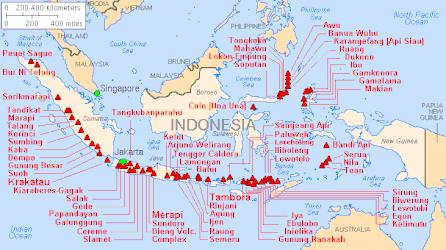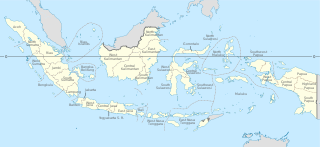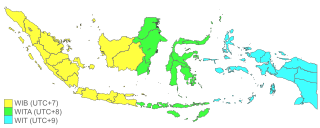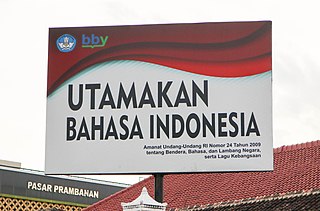
The region comprising the other 21 provinces in Sumatra, Java, and Kalimantan is known as Western Indonesia. [1] [2]

The region comprising the other 21 provinces in Sumatra, Java, and Kalimantan is known as Western Indonesia. [1] [2]

The main islands of Sumatra, Java, Madura, and Kalimantan lie on the Sunda Plate. Indonesia has relatively high tectonic and volcanic activities. It lies on the convergence between the Eurasian, Indo-Australian, Pacific, and Philippine Sea Plate. The Sunda megathrust is a 5,500 km long fault located off southern coasts of Sumatra, Java and Lesser Sunda Islands, where the Indo-Australian Plate is thrusting northeastward towards the subducting Sunda Plate.Tectonic movement in this fault is responsible for the creation of the Sunda Trench, and mountain ranges across Sumatra, Java. [3] Mount Merapi, located in the Java portion of the megathrust, is the most active volcano in Indonesia and is designated as one of world's Decade Volcanoes due to the hazard it poses to the surrounding populated areas. [4]

Borneo is the third largest island in the world and the native vegetation was mostly Borneo lowland rain forests although much of this has been cleared with wildlife retreating to the Borneo montane rain forests inland. Kalimantan and Sumatra, experience only slight differences in rainfall and temperature between the seasons, whereas others, such as Nusa Tenggara, experience far more pronounced differences with droughts in the dry season, and floods in the wet. Rainfall in Indonesia is plentiful, particularly in West Sumatra, Northwest Kalimantan, West Java.
Below are the top 13 provinces in Western Indonesia ranked by GDP in 2019:
| Rank | Province | Region | GDP (in billion Rp) | GDP nominal | GDP PPP | |
|---|---|---|---|---|---|---|
| (in billion $) | Comparable country | (in billion $) | ||||
| - | South East Asia | 16,073,257 | 1,136.72 | 3,329.17 | ||
| 1 | Java | 2,840,828 | 200.91 | 588.42 | ||
| 2 | Java | 2,352,425 | 166.37 | 487.27 | ||
| 3 | Java | 2,125,158 | 150.30 | 440.19 | ||
| 4 | Java | 1,362,457 | 96.35 | 282.18 | ||
| 5 | Sumatra | 801,733 | 56.70 | 166.06 | ||
| 6 | Sumatra | 765,198 | 54.12 | 158.51 | ||
| 7 | Java | 664,963 | 47.03 | 137.74 | ||
| 8 | Kalimantan | 653,677 | 46.23 | 135.40 | ||
| 9 | Sumatra | 455,233 | 32.19 | 94.28 | ||
| 10 | Sumatra | 360,664 | 25.51 | 74,71 | ||
| 11 | Sumatra | 268,080 | 18.96 | 55.53 | ||
| 12 | Sumatra | 246,423 | 17.42 | 51.01 | ||
| 13 | Sumatra | 217,712 | 15.40 | 45.10 | ||
In 2012, the DMO was 24.72%. Starting from 2014, no low-grade coal exports are allowed, so the upgraded brown coal process that cranks up the calorie value of coal from 4,500 to 6,100 kcal/kg will be built in South Kalimantan and South Sumatra. [5] [6] [7] Major Japanese factories are concentrated east of Jakarta with high concentrations in Bekasi, Cikarang and Karawang, West Java.
Jakarta is the largest city and the only megacity in Indonesia, with a population of 10.70 million. As a primate city, Jakarta is nearly four times larger than the second largest city Surabaya. Jakarta's status is unique compared to other cities in Indonesia, since it is technically a province with a city management. It is subdividied into five administrative cities and an administrative regency, which are not self-governed (without municipal council nor government budget). All five of Jakarta's satellite cities also have passed one million mark in population, with the largest one being Bekasi.
The other largest cities by region include Medan (Sumatra, also the largest outside of Java), Samarinda (Kalimantan).
Below are the populations of each provinces which make up the total population of Western Indonesia:
| Province | Population (2010 census) | Urban % in 2010 | Total Fertility Rate | Population (2015 census) |
|---|---|---|---|---|
| Aceh | 4,494,410 | 23.6 | 2.79 | 4,496,570 |
| North Sumatra | 12,982,204 | 42.4 | 3.01 | 13,923,262 |
| West Sumatra | 4,846,909 | 29.0 | 2.91 | 5,190,577 |
| Riau | 5,538,367 | 43.7 | 2.82 | 6,330,941 |
| Jambi | 3,092,265 | 28.3 | 2.51 | 3,397,164 |
| South Sumatra | 7,450,394 | 34.4 | 2.56 | 8,043,042 |
| Bengkulu | 1,715,518 | 29.4 | 2.51 | 1,872,136 |
| Lampung | 7,608,405 | 21.0 | 2.45 | 8,109,601 |
| Bangka Belitung Islands | 1,223,296 | 43.0 | 2.54 | 1,370,331 |
| Riau Islands | 1,679,163 | 67.4 | 2.38 | 1,968,313 |
| Banten | 10,632,166 | 52.2 | 2.35 | 11,934,373 |
| Jakarta | 9,607,787 | 100.0 | 1.82 | 10,154,134 |
| West Java | 43,053,732 | 50.3 | 2.43 | 46,668,214 |
| Central Java | 32,382,657 | 40.4 | 2.20 | 33,753,023 |
| Yogyakarta | 3,457,491 | 57.7 | 1.94 | 3,675,768 |
| East Java | 37,476,757 | 40.9 | 2.00 | 38,828,061 |

Indonesia recognizes only a single national language, and indigenous languages are recognized at the regional level, although policies vary from one region to another. For example, in the Special Region of Yogyakarta, the Javanese language is the region's official language along with Indonesian. [8] The next most widely spoken regional languages in the country are Sundanese, local Malay, and Minangkabau. There are hundreds of indigenous languages spoken in Indonesia. Most of them are locally used indigenous languages, [9] a category of languages referring to those spoken at the local, regional level, spoken by a small number of people, ranging from a few to a few thousands of people. These include small languages such as Benggoi, Mombum and Towei. [10] [ page needed ] Other languages are spoken at the regional level to connect various ethnicities. For this reason, these languages are known as regional lingua francas (RLFs). According to Subhan Zein, there are at least 43 RLFs in Indonesia, categorized into two types: Malayic RLFs and Non-Malayic RLFs. The former refers to a group of regional lingua francas that are thought of as indigenised varieties of Malay or Indonesian. These include such languages like Banjar Malay among others. The latter refers to regional lingua francas that are not associated with Malay or Indonesian, like Iban. [11] [10] [ page needed ] [lower-alpha 1]
The population numbers given below are of native speakers, excepting the figure for Indonesian, which counts its total speakers.
Religion was a census variable in the 1961, 1971, 1980, 1990, 2000, and 2010 and in various intercensal surveys. Being deemed divisive, the 1961 census data regarding religion was not published. In 1971, three groups of Christians were recorded: Catholic, Protestant and other. The U.N. Demographic Yearbook 1979 only lists data collectively for all Christians. In the 2000 census, only Catholics and Protestants were available as categories. [14]
Religious composition by ethnic group [15]
| Ethnic Group | Muslims | Christians | Hindus | Buddhists | Confucians | Others | Total |
|---|---|---|---|---|---|---|---|
| Javanese | 92,107,046 | 2,428,121 | 160,090 | 90,465 | 2,857 | 9,599 | 94,788,943 |
| Sundanese | 36,450,022 | 29,332 | 1,851 | 24,528 | 4,854 | 155,308 | 36,665,892 |
| Malay | 8,643,370 | 8,484 | 1,031 | 19,848 | 1,243 | 242 | 8,751,218 |
| Batak | 3,738,660 | 4,707,658 | 1,476 | 9,190 | 315 | 6,305 | 8,463,604 |
| Madurese | 7,157,518 | 7,695 | 368 | 435 | 32 | 43 | 7,166,091 |
| Betawi | 6,607,019 | 151,429 | 1,161 | 39,278 | 1,805 | 252 | 6,800,943 |
| Minangkabau | 6,441,071 | 1,822 | 179 | 1,255 | 49 | 44 | 6,459,420 |
| Buginese | 6,348,200 | 35,516 | 26,102 | 957 | 47 | 2,395 | 6,413,217 |
| Bantenese | 4,634,374 | 4,810 | 101 | 2,680 | 70 | 242 | 4,642,277 |
| Banjarese | 4,108,104 | 15,775 | 994 | 1,396 | 62 | 410 | 4,126,741 |
| Balinese | 127,274 | 49,385 | 3,736,993 | 10,378 | 142 | 473 | 3,924,645 |
| Acehnese | 3,398,818 | 403 | 70 | 1,028 | 7 | 4 | 3,403,961 |
| Dayak | 1,016,697 | 2,017,870 | 12,140 | 17,502 | 568 | 154,219 | 3,218,996 |
| Sasak | 3,153,671 | 5,540 | 4,555 | 10,682 | 7 | 439 | 3,174,894 |
| Chinese | 131,682 | 1,211,692 | 3,552 | 1,388,829 | 94,005 | 1,114 | 2,830,874 |

Indonesia is an archipelagic country located in Southeast Asia and Oceania, lying between the Indian Ocean and the Pacific Ocean. It is located in a strategic location astride or along major sea lanes connecting East Asia, South Asia and Oceania. Indonesia is the largest archipelago in the world. Indonesia's various regional cultures have been shaped—although not specifically determined—by centuries of complex interactions with its physical environment.

Sumatra is one of the Sunda Islands of western Indonesia. It is the largest island that is fully within Indonesian territory, as well as the sixth-largest island in the world at 475,807.63 km2 (182,812 mi.2), including adjacent islands such as the Simeulue, Nias, Mentawai, Enggano, Riau Islands, Bangka Belitung and Krakatoa archipelago.

Provinces are the first-level administrative divisions of Indonesia. It is formerly called the first-level provincial region provinsi daerah tingkat I) before the Reform era. Provinces have a local government, consisting of a governor and a regional legislative body. The governor and members of local representative bodies are elected by popular vote for five-year terms, but governors can only serve for two terms. Provincial governments have the authority to regulate and manage their own government affairs, subject to the limits of the central government.

Minangkabau is an Austronesian language spoken by the Minangkabau of West Sumatra, the western part of Riau, South Aceh Regency, the northern part of Bengkulu and Jambi, also in several cities throughout Indonesia by migrated Minangkabau. The language is also a lingua franca along the western coastal region of the province of North Sumatra, and is even used in parts of Aceh, where the language is called Aneuk Jamee.

West Kalimantan is a province of Indonesia. It is one of five Indonesian provinces comprising Kalimantan, the Indonesian part of the island of Borneo. Its capital and largest city is Pontianak. It is bordered by East Kalimantan and Central Kalimantan to the east, the Malaysian state of Sarawak to the north, and the Pacific Ocean to the west and the Java Sea to the south. The province has an area of 147,307 km2, and had a population of 4,395,983 at the 2010 Census and 5,414,390 at the 2020 Census; the official estimate as at mid 2022 was 5,541,376. Ethnic groups include the Dayak, Malay, Chinese, Javanese, Bugis, and Madurese. The borders of West Kalimantan roughly trace the mountain ranges surrounding the vast watershed of the Kapuas River, which drains most of the province. The province shares land borders with Central Kalimantan to the southeast, East Kalimantan to the east, and the Malaysian territory of Sarawak to the north.

South Sumatra is a province of Indonesia, located in the southeast of the island of Sumatra. The capital and largest city of the province is the city of Palembang. The province borders the provinces of Jambi to the north, Bengkulu to the west and Lampung to the south, as well a maritime border with the Bangka Belitung Islands to the east. It is the largest province in the island of Sumatra, and it is slightly smaller than Portugal. The Bangka Strait in the east separates South Sumatra and the island of Bangka, which is part of the Bangka Belitung Islands province. The province has an area of 91,592.43 km2 (35,364 sq mi) and had a population of 8,467,432 at the 2020 Census; the official estimate as at mid-2022 was 8,657,008. The province is rich in natural resources, such as petroleum, natural gas and coal. The province is inhabited by many different ethnic groups, with Palembangese being largest ethnic group. Most speak the Palembang language, which is mutually intelligible to both Indonesian and local Palembang Malay. Other ethnic groups include the Javanese, Sundanese, Minangkabau and Chinese. Most are concentrated in urban areas and are largely immigrants from other parts of Indonesia.

Bengkulu, historically known as Bencoolen, is a province of Indonesia. It is located on the southwest coast of Sumatra. It was formed on 18 November 1968 by separating out the area of the historic Bencoolen Residency from the province of South Sumatra under Law No. 9 of 1967 and was finalized by Government Regulation No. 20 of 1968. Spread over 20,130.21 km2, it is bordered by the provinces of West Sumatra to the north, Jambi to the northeast, Lampung to the southeast, and South Sumatra to the east, and by the Indian Ocean to the northwest, south, southwest, and west.

The Bangka Belitung Islands is a province of Indonesia. Situated off the southeastern coast of Sumatra, the province comprises two main land masses — Bangka and Belitung — and numerous smaller islands. Bangka Belitung is bordered by the Bangka Strait to the west, the Natuna Sea to the north, the Java Sea is to the south and the Karimata Strait to the east. The province's capital and largest city is Pangkalpinang. The province shares maritime borders with South Sumatra to the west, Riau Islands to the north, Banten, the Special Capital Region of Jakarta, West Java, and Central Java to the south, and West Kalimantan to the east. Bangka Belitung covers a land area of 16,690.54 km2 (6,444.25 sq mi) and had a population of 1,455,678 according to the 2020 census; the official estimate as at mid 2022 was 1,494,621.
In addition to its classical and literary form, Malay had various regional dialects established after the rise of the Srivijaya empire in Sumatra, Indonesia. Also, Malay spread through interethnic contact and trade across the south East Asia Archipelago as far as the Philippines. That contact resulted in a lingua franca that was called Bazaar Malay or low Malay and in Malay Melayu Pasar. It is generally believed that Bazaar Malay was a pidgin, influenced by contact among Malay, Hokkien, Portuguese, and Dutch traders.

The Republic of Indonesia, a country located in Southeast Asia, comprise many islands, prompting the government to recognise three time zones. Western Indonesia Time is seven hours ahead (UTC+07:00) of the Coordinated Universal Time (UTC), used in the islands of Sumatra, Java, and the western half of Kalimantan. Central Indonesia Time is eight hours ahead (UTC+08:00), used in the eastern half of Kalimantan, as well as all of Bali, the Lesser Sunda Islands, and Sulawesi. Eastern Indonesia Time is nine hours ahead (UTC+09:00), used in the Maluku Islands and Western New Guinea.

Indonesians are citizens or people who are identified with the country of Indonesia, regardless of their ethnic or religious background. There are more than 1,300 ethnicities in Indonesia, making it a multicultural archipelagic country with a diversity of languages, culture and religious beliefs. The population of Indonesia according to the 2020 national census was 270.2 million. 56% live on the island of Java, the world's most populous island. Around 95% of Indonesians are Native Indonesians, with 40% Javanese and 15% Sundanese forming the majority, while the other 5% are Indonesians with ancestry from foreign origin, such as Arab Indonesians, Chinese Indonesians, Indian Indonesians, and Indos.

The Banjar or Banjarese are an Austronesian ethnic group native to the Banjar regions in the southeastern Kalimantan regions of Indonesia. Nowadays, Banjarese diaspora can be found in neighbouring Banjar regions as well; including Kotabaru Regency, the southeastern regions of Central Kalimantan, southernmost regions of East Kalimantan, and some provinces of Indonesia in general. The Banjarese diaspora community also can be found in neighbouring countries of Indonesia, such as Brunei, Malaysia, and Singapore.

There are 1,340 recognised ethnic groups in Indonesia. The vast majority of those belong to the Austronesian peoples, with a sizeable minority being Melanesians. Indonesia has the world's largest number of Austronesians and Melanesians.

More than 700 living languages are spoken in Indonesia. This figure indicates that Indonesia has about 10% of the world's languages, establishing its reputation as the second most linguistically diverse nation in the world after Papua New Guinea. Most languages belong to the Austronesian language family, while there are over 270 Papuan languages spoken in eastern Indonesia. The language most widely spoken as a native language is Javanese.
This is a list of some of the regions of Indonesia. Many regions are defined in law or regulations by the central government. At different times of Indonesia's history, the nation has been designated as having regions that do not necessarily correlate to the current administrative or physical geography of the territory of the nation.

Malay Indonesians are ethnic Malays living throughout Indonesia. They are one of the indigenous peoples of the country. Indonesian, the national language of Indonesia, is a standardized form of Riau Malay. There were numerous kingdoms associated with the Indonesian Malays along with other ethnicities in what is now Indonesia, mainly on the islands of Borneo and Sumatra. These included Srivijaya, the Melayu Kingdom, Dharmasraya, the Sultanate of Deli, the Sultanate of Siak Sri Indrapura, the Riau-Lingga Sultanate, the Sultanate of Bulungan, Pontianak Sultanate, and the Sultanate of Sambas. The 2010 census states that there are 8 million Malays in Indonesia; this number comes from the classification of Malays in East Sumatra and the coast of Kalimantan which is recognized by the Indonesian government. This classification is different from the Malaysia and Singapore census which includes all ethnic Muslims from the Indonesian archipelago as Malays.

The following outline is provided as an overview of and topical guide to Indonesia:
Palembang, also known as Palembang Malay, or Musi, is a Malayic language primarily spoken in about two thirds of South Sumatra Province in Indonesia, especially along the Musi River. It consists of two separate but mutually intelligible dialect chains: Musi and Palembang. The urban Palembang dialect is a koiné that emerged in Palembang, the capital city of South Sumatra. It has become a lingua franca throughout major population centers in the province, and is often used polyglossically with Indonesian and other regional languages and dialects in the area. Since parts of South Sumatra used to be under direct Malay and Javanese rule for quite a long time, the speech varieties of Palembang and its surrounding area are significantly influenced by Malay and Javanese, down to their core vocabularies.
Kendayan, or Salako (Selako), is a Malayic Dayak language of Borneo. The exact number of speakers remains unknown, but is estimated to be around 350,000.